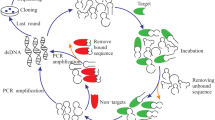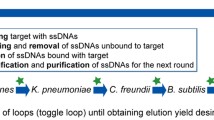Abstract
Peptidoglycan is a highly complex and essential macromolecule of bacterial outer cell wall; it is a heteropolymer made up of linear glycan strands cross-linked by peptides. Peptidoglycan has a particular composition which makes it a possible target for specific bacterial recognition. Aptamers are single-stranded DNA or RNA oligonucleotides that bind to target molecules with high affinity and specificity. Aptamers can be labeled with different radioisotopes and possess several properties that make them suitable for molecular imaging. The purpose of this study was to obtain aptamers for use as radiopharmaceutical in bacterial infection diagnosis. Two aptamers (Antibac1 and Antibac2) against peptidoglycan were selected through the Systematic Evolution of Ligands by Exponential Enrichment (SELEX) methodology. The dissociation constant (Kd) for Antibac1 was 0.415 + 0.047 μM and for Antibac2 was 1.261 + 0.280 μM. These aptamers labeled with 32P showed high affinity for Staphylococcus aureus cells. The binding to S. aureus and Escherichia coli in vitro were significantly higher than for Candida albicans and human fibroblasts, demonstrating their specificity for bacterial cells. These results point Antibac1 and Antibac2 as promising tools for bacterial infections identification.




Similar content being viewed by others
References
Jensen, A. G., Wachmann, C. H., Espersen, F., Scheibel, J., Skinhoj, P., & Frimodt-Moller, N. (2002). Archives of Internal Medicine, 162, 25–32.
Verhagen, D. W., van der Meer, J. T., Hamming, T., de Jong, M. D., & Speelman, P. (2003). Scandinavian Journal of Infectious Diseases, 35, 459–463.
Lautenschlager, S., Herzog, C., & Zimmerli, W. (1993). Clinical Infectious Diseases, 16, 567–573.
Cuijpers, M. L., Vos, F. J., Bleeker-Rovers, C. P., Krabbe, P. F., Pickkers, P., van Dijk, A. P., Wanten, G. J., Sturm, P. D., Oyen, W. J., & Kullberg, B. J. (2007). European Journal of Clinical Microbiology and Infectious Diseases, 26, 105–113.
Ferro-Flores, G., Ocampo-Garcia, B. E., & Melendez-Alafort, L. (2012). Current Pharmaceutical Design, 18, 1098–1106.
Welling, M. M. F.-F., Guillermina; Pirmettis, Ioannis; Brouwer, Carlo P.J.M. (2009) Anti-Infective Agents in Medicinal Chemistry (Formerly Current Medicinal Chemistry-Anti-Infective Agents) 8, 272-287.
Ellington, A. D., & Szostak, J. W. (1990). Nature, 346, 818–822.
Tuerk, C., & Gold, L. (1990). Science, 249, 505–510.
Missailidis, S., & Perkins, A. (2007). Cancer Biotherapy and Radiopharmaceuticals, 22, 453–468.
Hong, H., Goel, S., Zhang, Y., & Cai, W. (2011). Current Medicinal Chemistry, 18, 4195–4205.
Franciscis, V., Rienzo, A. and Cerchia, L. (2012) in Nucleic Acid Aptamers for In Vivo Molecular Imaging, Molecular Imaging (Schaller, B., Ed.) InTech, Rijeka, Croatia, pp. 95-116.
Zuker, M. (2003). Nucleic Acids Research, 31, 3406–3415.
Gold, L., Polisky, B., Uhlenbeck, O., & Yarus, M. (1995). Annual Review of Biochemistry, 64, 763–797.
Yang, Q., Goldstein, I. J., Mei, H. Y., & Engelke, D. R. (1998). Proceedings of the National Academy of Sciences of the United States of America, 95, 5462–5467.
Masud, M. M., Kuwahara, M., Ozaki, H., & Sawai, H. (2004). Bioorganic & Medicinal Chemistry, 12, 1111–1120.
Low, S. Y., Hill, J. E., & Peccia, J. (2009). Biochemical and Biophysical Research Communications, 378, 701–705.
Silhavy, T. J., Kahne, D., & Walker, S. (2010). Cold Spring Harbor Perspectives in Biology, 2, a000414.
Bowman, S. M., & Free, S. J. (2006). Bioessays, 28, 799–808.
Vivekananda, J., & Kiel, J. L. (2006). Laboratory Investigation, 86, 610–618.
Dwarakanath, S., Bruno, J. G., Shastry, A., Phillips, T., John, A. A., Kumar, A., & Stephenson, L. D. (2004). Biochemical and Biophysical Research Communications, 325, 739–743.
Bruno, J. G., Carrillo, M. P., Phillips, T., & Andrews, C. J. (2010). Journal of Fluorescence, 20, 1211–1223.
Chen, F., Zhou, J., Luo, F., Mohammed, A. B., & Zhang, X. L. (2007). Biochemical and Biophysical Research Communications, 357, 743–748.
Cao, X., Li, S., Chen, L., Ding, H., Xu, H., Huang, Y., Li, J., Liu, N., Cao, W., Zhu, Y., Shen, B., & Shao, N. (2009). Nucleic Acids Research, 37, 4621–4628.
Hamula, C. L., Le, X. C., & Li, X. F. (2011). Analytical Chemistry, 83, 3640–3647.
Dwivedi, H. P., Smiley, R. D., & Jaykus, L. A. (2013). Applied Microbiology and Biotechnology, 97, 3677–3686.
Bruno, J. G., & Kiel, J. L. (1999). Biosensors and Bioelectronics, 14, 457–464.
Acknowledgments
This research was supported by the Centro de Desenvolvimento da Tecnologia Nuclear/Comissão Nacional de Energia Nuclear (CDTN/CNEN), Fundação de Amparo a Pesquisa do Estado de Minas Gerais (FAPEMIG) and Coordenação de Aperfeiçoamento de Pessoal de Nível Superior (CAPES).
Author information
Authors and Affiliations
Corresponding author
Rights and permissions
About this article
Cite this article
Ferreira, I.M., de Souza Lacerda, C.M., de Faria, L.S. et al. Selection of Peptidoglycan-Specific Aptamers for Bacterial Cells Identification. Appl Biochem Biotechnol 174, 2548–2556 (2014). https://doi.org/10.1007/s12010-014-1206-6
Received:
Accepted:
Published:
Issue Date:
DOI: https://doi.org/10.1007/s12010-014-1206-6




